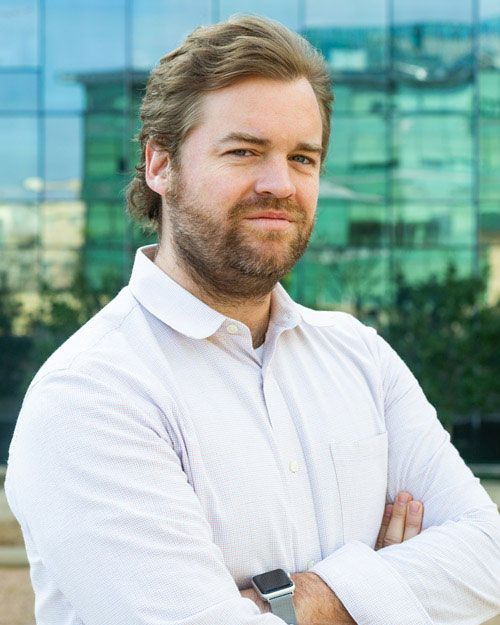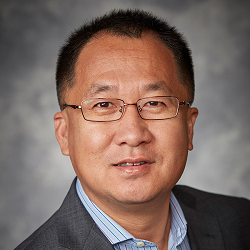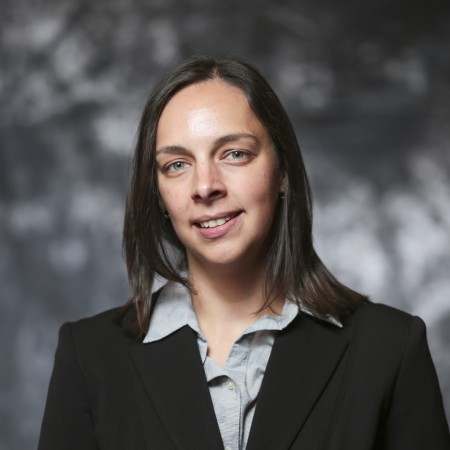Faculty REU projects
Research topic: Photochromic semiconducting polymers
In the Biewer lab, the REU students will learn to synthesize photochromic semiconducting small molecules and test their optoelectronic properties in the two photochromic states. Recently, our group synthesized photochromic bicyclic aziridine molecules that are attached to thiophene and are photochromic. The bicyclic aziridine can convert between the closed form and the zwitterionic open form through UV irradiation. The goal of this project is to generate semiconducting small molecules that change conductivity depending on the state of the photochromic compound. The significant differences in electronic properties for the open and closed forms of the bicyclic aziridine will presumably affect a large change in the semiconducting properties of the material.
The REU student will learn synthetic techniques to prepare monomers, test the small molecule optically in both the closed and open forms, and record the electronic properties of the small molecule and in both states. The REU student will directly use knowledge gained in OFET preparation to study transistor properties of the small molecule in both states and will learn how to adapt synthetic skills in the lab to prepare functional devices.
Research topic: Fragment-coupling approaches for complex molecule synthesis
There is an established need in medicinal chemistry for new methods to prepare highly saturated molecules that contain multiple stereogenic centers (complex molecules). Students in the Delaney lab use expertise in transition metal catalysis and physical organic chemistry to develop new methods for the synthesis of saturated, complex molecules. Our goal is to develop general fragment coupling methods that can join two potentially complex molecules to form a new structure that is more than the sum of its parts. Our highest aspiration is to make it as easy to construct libraries of complex molecules as it is to snap together biaryl compounds with the Suzuki-Miyaura reaction.
An REU student in the Delaney lab would join the ongoing development of a reaction that couples two strained rings to make a saturated heterocycle. The student would help with the final optimization of the reaction conditions by testing how the use of different bases and transition metal catalysts affects the generality of the reaction. Furthermore, the student would synthesize a variety of saturated heterocycles to evaluate the scope of the reaction. Through direct research experience, students can expect to learn advanced organic synthesis techniques including handling of air- and water-sensitive materials, and gain experience developing new transition metal catalysts. Through group activities, students will also learn about the physical organic techniques that are used to interrogate reaction mechanisms.
Research topic: Pyrrole-based semiconductors
Research in Stefan group targets the synthesis of novel conjugated pyrrole molecules for organic electronics applications. The Stefan group reported the molecular design, synthesis, characterization, device fabrication, and mobility calculation of a few pyrrole-based molecules. The REU student will learn how to synthesize the pyrrole-based conjugated small molecule through a Stille cross-coupling method. Optical and electrochemical techniques, such as UV-Vis spectrophotometry and cyclic voltammetry (CV), will be employed to determine the opto-electronic properties of the small molecule. The REU student will test the synthesized organic semiconductor pyrrole molecule in the OFET device. The fabrication of OFET will take place after basic training as a certified user. As the final step, the devices prepared by the student will be examined with a cascade probe station to determine the field-effect mobility. The training provided in OFET preparation for the REU students will be directly used in this project.
Research topic: Dynamic covalent chemistry in 3D printing
Work in the Smaldone Lab targets the development of new chemical strategies in fused filament fabrication (FFF) for printing previously “unprintable” materials, such as thermoset polymers and soft materials using dynamic covalent chemistry. One of the limitations of FFF arises from the low mechanical strength of the printed parts caused by weak adhesion between the filament layers that are deposited after each pass by the hot print head. To address this problem, we took inspiration from self-healing polymer chemistry to design and synthesize a crosslinked polymer (or “mending agent,” MA) using short di- and tri-functional linkers that were polymerized through a reversible furan maleimide Diels-Alder reaction (fmDA). The role of this MA polymer is to partially depolymerize during the printing process and then re-polymerize as the printed object cools, thus forming new covalent bonds between the printed layers. To evaluate this hypothesis, the MA was blended into a polylactic acid (PLA) matrix, and mechanical tests were carried out on 3D printed samples. The REU student will gain experience in a variety of techniques, including the synthesis and characterization of monomers and polymers as well as the design of new printable objects. The experiences gained in this project will highlight the advantages, and differences, of “soft” chemistry to prepare 3D printed materials compared to devices made in an OFET preparation.
Research topic: Biological templates for energy materials
Research in the Gassensmith group focuses on biomaterials as templates for high-density energy storage. Hierarchical porous carbons (HPC) are a class of materials that are fabricated to reach a high surface area, multi-scale porosity, heteroatoms doping, excellent conductivity, and stability, which are characteristics that are highly sought after in adsorbents, catalysis, energy conversion, and energy storage. Conventional fabrications of HPCs rely on using synthetic inorganic/organic templates or chemical activation that generally require multiple steps beginning with template syntheses, followed by precursor infiltration, carbonization, and template removal to generate the desired heterogeneous porosity. Over the previous two decades, metal-organic frameworks (MOFs) have become a popular architecture for advanced materials due to their highly customizable pore structure, composition, and synthetic strategies. MOFs are also recognized as promising precursors for porous carbons. Because of their characteristic porous nature and high carbon content, MOF precursors enable one-step conversion to porous carbons possessing high surface area with an inner-connected porous architecture. In recent years, MOF synthesis has reached a new milestone with its crossover with biologically derived substrates, producing an ever-growing array of bio-MOF composites featuring morphology and size that are dictated, in part, by the underlying biological material used. In addition to potential benefits such as environmental friendliness, low cost, and high efficiency, the available biomass to template MOF syntheses is extraordinary—viruses and yeast have already been shown to be great templates to produce core-shell systems. Researchers have only begun to explore the potential uses of biomass as homogenous and low-cost templates for new MOF architectures. For instance, bacteria’s high reproduction rate, ease of maintenance, and natural abundance make it an ideal source of cheap precursor materials – indeed, our body contains at least three times more bacterial cells than human cells.
REU students in the Gassensmith lab will learn bio-inspired preparation of MOF-derived HPCs driven by a robust, non-pathogenic, nontoxic bacterial template. The REU student working on this project will be exposed to how materials work is related to both OFET measurements to study electronic properties and the biological influence with microfluidic devices.
Research topic: Synthesis of metal nanoparticles
In the Zheng lab, the REU student will work on fundamental understandings of the luminescence properties of plasmonic metal nanoparticles and bioimaging applications of these nanoparticles. Luminescent noble metal nanoparticles have emerged as a novel class of nanomaterials, which are different from conventional non-luminescent plasmonic gold nanoparticles. However, most of the luminescent metal nanoparticles are ultrasmall and exhibit no surface plasmons. As a result, how the surface plasmon couples with luminescence in the metal nanoparticles is still mostly unknown. In the past decade, we have developed a class of luminescent and plasmonic noble metal nanoparticles that offers an exciting opportunity to probe the coupling between surface plasmons and luminescence. The REU student will be dedicated to developing new nanochemistry that can control the grain size distribution at the ensemble level and further correlate the grain size with the luminescence property. The student will apply these nanoparticles in cellular imaging and investigate how these nano-bio interactions impact luminescence properties, including photostability, emission wavelengths, etc.
The REU student is expected to gain the following: (1) fundamental understanding of optical properties of metal nanoparticles, in particular, luminescence; (2) unraveling of the coupling between surface plasmons and luminescence; (3) development of novel nanochemistry for precise control of grain size in the metal nanoparticles; and (4) discovery of nano-bio interactions enabled by these luminescent plasmonic metal nanoparticles.
Research topic: Hybrid nano-scale lipid-protein vesicles to study transporter proteins
In the Meloni lab, the REU student will synthesize small unilamellar lipid-protein vesicles (proteoliposomes) to study transport properties toward 2nd– and 3rd-row transition metals of transmembrane Cu(I)-pumps embedded in lipid bilayers. In biological systems, the flux across lipid bilayers of essential and toxic transition metals is mediated by ion pumps and transporter proteins present in cellular membranes. Although the structure and function of several metal pumps has been established, the overall mechanism for substrate translocation, transport kinetics, and electrogenicity remains elusive due to the lack of tools for in vitro characterization of purified pumps and transporters embedded in artificial lipids bilayers for investigating metal translocation events in real time. We developed a coupled experimental platform that permits the reconstitution of transmembrane transporters, such as Cu(I)-pumps, in nanometer scale (100–200 nm) hybrid small unilamellar lipid vesicles (proteoliposomes) coupled to the encapsulation in the lumen of multiple fluorescence reporter probes. This allows real-time study of the metal transport mechanism and translocation kinetics.
The REU student will develop and synthesize proteoliposomes with encapsulated fluorescence sensors to investigate Ag(I) and Pt(II)-complexes translocation across the membrane by Cu(I)-pumps (Figure 8b). The student will learn to recombinantly express, purify, and reconstitute prokaryotic Cu(I)-pumps in assembled lipid vesicles (i.d. 200 nm) and then encapsulate in the proteoliposome lumen fluorescent probes for Ag(I) (Phen Green SK, a Cu(I)/Ag(I)-dependent fluorescent turn-off probe) and for Pt(II)-complexes (e.g., cisplatin, oxaliplatin, and carboplatin). Thus, the student will contribute to the development of a novel liposome experimental setup centered on multiple fluorescence reporters that will allow the study of transport mechanisms for selected 2nd– and 3rd-row transition metals, gaining hands-on experience with biochemical, bioinorganic, and biophysical techniques.
Research topic: Dynamics of macromolecular protein-nucleic acid complexes
In the D’Arcy laboratory, the REU students will study how large protein-nucleic acid complexes are influenced by protein and nucleic acid sequence and modification. The specific system under study will be the nucleosome, the basic building block of the genomic material that is composed of histone proteins and DNA. The D’Arcy laboratory is experienced in the recombinant expression and purification of various histone proteins and engineered DNA constructs that can be reconstituted to make nucleosomes. The REU students will use these well-established protocols to produce both ‘canonical’ and ‘modified’ nucleosomes for comparison. The modified nucleosomes are biologically significant such as the incorporation of a histone variant, the acetylation of a histone tail, or the use of a different DNA sequence. The REU students will gain experience in fundamental biochemical approaches, including recombinant techniques, chromatography, electrophoresis, and spectroscopy.
The REU students will subsequently use bio-analytical approaches to compare the solution dynamics of canonical and modified nucleosomes. The primary technique will be hydrogen-deuterium exchange coupled with mass spectrometry (HDX), with the exchange rate being compared between the two samples. HDX experiments require precision and analytical skills that the REU students will have learned and practiced in the shared clean room experience. Alongside the standard bottom-up HDX workflow in the D’Arcy laboratory, the REU students will be encouraged to attempt or theoretically consider performing one or more steps in the HDX workflow in the microfluidic device. Others have used microfluidic devices for HDX. A comparison between the device and device-free conditions can be performed. We expect distinct solution dynamics of canonical and modified nucleosomes as currently functional effects are not adequately explained by static structures. The REU students will gain hands-on experience with the LC-MS system in the D’Arcy laboratory, which includes a high-resolution ESI-Q-TOF with MS/MS and ion mobility capabilities.







